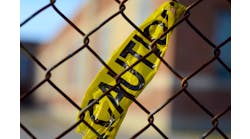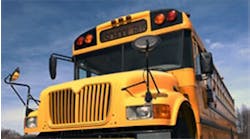How can a school be designed as a safe haven for learning? Do we place cameras everywhere, lock doors and cover windows? These are solutions to a certain degree, but more is involved in defining the school environment as “student-safe.” Both technical solutions and design strategies are essential to creating safe learning environments.
TECHNICAL SOLUTIONS:
•Minimize key access on exterior doors and provide greater use of card readers for access control.
•In situations where card readers are cumbersome to school operation, use cameras and intercoms.
•Determine which doors absolutely need access. If access is not required, do not provide exterior provisions for access; provide for code egress only.
•Provide exterior doors with door position switches that identify when a door is held open or not closed.
•Install laminated glass at entrances.
•Main entries that require visitors to pass through the central office before gaining access to the rest of the building recently have been questioned, because an intruder could forcibly pass through the office. Panic buttons in several locations (e.g., reception desk, principal’s office, etc.) can lock down all doors.
•Exterior main entry doors typically are controlled electronically; this must be coordinated with handicapped access. How much electronic control is needed at the vestibule doors beyond just the main entry door, which will allow visitor access?
•Compartmentalizing the building can provide added security.
•Specify an “intruder” function on locksets for doors that enter into a space with children. This enables the lockset to lock the outside lever from the interior of the room.
•Strategically situate high-resolution cameras (with proper recording times) at site and building entrances.
•Design two-way communications from the central administration to all rooms.
•Throughout a building interior, provide walkthrough security lighting that is visible from the exterior.
•Cover radio-frequency communication throughout the school.
•Incorporate generator backup power supply for phones and emergency communications.
DESIGN STRATEGIES:
•A welcoming site entrance with appropriate signage and lighting.
•Easily identifiable vehicular/pedestrian pathways to route visitors immediately toward designated areas.
•Designated and ample visitor parking near the main entrance.
•Well-marked entrance doors clustered together in lieu of numerous dispersed single doors, which are difficult to supervise.
•Labeled entrances to communicate after-hour access for special events.
•Entrances open to view for patrol visibility and camera recording. Avoid wide columns, screen walls, heavy landscaping and berms.
•Walls of appropriate height with secure gates to prevent access to unsupervised areas.
•Glare-controlled and well-lighted areas at window locations.
•A direct view of the main entrance from administrative areas, and of a visitor from the reception area.
•Controlled access at the main entrance that “holds” visitors until verification is completed for check-in.
•Building zoning that enables after-hours community use and secures unused areas.
•Staff planning areas with glazing that provides views into student areas.
•Low-height student lockers in commons areas for easy supervision.
Designing a school with clusters to break down the scale of student enrollment provides an opportunity for students to know one another and teachers, and to become accustomed to circulation paths.
Collaborative teaming areas, fewer corridors and more access to communications technology can help establish a student-safe learning environment from within and protect a school from outsiders.


